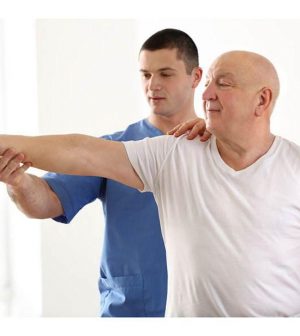- Skip Storing This Everyday Product in the Fridge Door
- Green Tea + B3 Pairing May Boost Brain Health
- Navigating Your Midlife Crisis: Embracing New Possibilities
- City Raccoons Showing Signs of Domestication
- Mapping the Exposome: Science Broadens Focus to Environmental Disease Triggers
- One Week Less on Social Media Linked to Better Mental Health
- Your Brain Changes in Stages as You Age, Study Finds
- Some Suicide Victims Show No Typical Warning Signs, Study Finds
- ByHeart Formula Faces Lawsuits After Babies Sickened With Botulism
- Switch to Vegan Diet Could Cut Your Greenhouse Gas Emissions in Half
Post-Stroke Rehab: There’s a Sweet Spot in the Timing

After a stroke, the best time to work on regaining hand and arm use is 60 to 90 days later, according to a new clinical trial.
Starting intensive rehab at less than 30 days can be helpful, too, but waiting until six months can be too late for maximum benefit, said researchers from Georgetown University and MedStar National Rehabilitation Network.
Nearly two-thirds of the 750,000 individuals who have a stroke each year in the United States do not recover complete function of their hands and arms. This can severely limit their everyday activities, the researchers said.
The study included 72 stroke survivors, mostly from the Washington, D.C. area, enrolled within three weeks after their stroke.
“Our results suggest that more intensive motor rehabilitation should be provided to stroke patients at 60 to 90 days after stroke onset,” said study co-author Elissa Newport, director of Georgetown’s Center for Brain Plasticity and Recovery.
“It is well known that a young developing brain shows great plasticity, compared to other times in life,” Newport said in a Georgetown news release. “Our results show that there may be a similar period of heightened plasticity for stroke patients at a specific time after their stroke.”
Researchers randomized participants into three groups, each assigned to 20 extra hours of activity-focused motor skills therapy. A control group received prescribed rehabilitation therapy but no extra motor rehabilitation. The groups with extra therapy started at 30 days after having a stroke, 60 to 90 days after, or six months or more.
The study team found improvements in hand and arm function great enough that patients noted functional changes.
“Our approach shows that patients can tolerate much more intensive motor training than is traditionally provided if they are free to choose the activities used in their training,” said Dorothy Edwards, professor of kinesiology and medicine at the University of Wisconsin-Madison and member of the Center for Brain Plasticity and Recovery.
“Knowing there might be a critical period for recovery, there are many techniques one might imagine bringing to bear on understanding and enhancing recovery during this time period,” Edwards said in the release.
The researchers are planning a larger clinical trial to confirm findings and determine the optimum dose of therapy.
The findings were published Sept. 20 in PNAS.
More information
The U.S. Centers for Disease Control and Prevention has more on recovering from a stroke.
SOURCE: Georgetown University Medical Center, news release, Sept. 20, 2021
Source: HealthDay
Copyright © 2025 HealthDay. All rights reserved.










